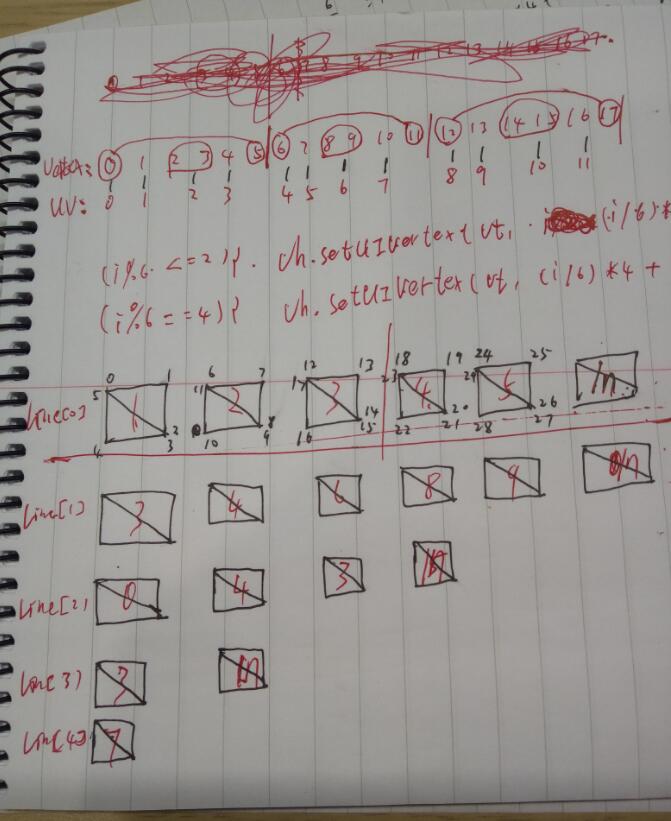使用UGU怎么调整Text中的字体间距?很多新手对此不是很清楚,为了帮助大家解决这个难题,下面小编将为大家详细讲解,有这方面需求的人可以来学习下,希望你能有所收获。
using System.Collections;
using System.Collections.Generic;
using UnityEngine;
using UnityEngine.UI;
public class TextSpacingTest : BaseMeshEffect
{
public float spacing = 0;
public override void ModifyMesh(VertexHelper vh)
{
List<UIVertex> vertexs = new List<UIVertex>();
vh.GetUIVertexStream(vertexs);
int vertexIndexCount = vertexs.Count;
for (int i = 6; i < vertexIndexCount; i++)
{
UIVertex v = vertexs[i];
v.position += new Vector3(spacing * (i / 6), 0, 0);
vertexs[i] = v;
if (i % 6 <= 2)
{
vh.SetUIVertex(v, (i / 6) * 4 + i % 6);
}
if (i % 6 == 4)
{
vh.SetUIVertex(v, (i / 6) * 4 + i % 6 - 1);
}
}
}
}分析代码:
1)首先创建一个字体间距的变量,然后需要继承BaseMeshEffect类并且实现其中的抽象的方法MeshModify()函数。
2)创建一个容器从网格信息生成器vh中将字体的顶点信息全部加载保存下来
3)接下来开始遍历获取到的顶点,我们知道每个字体是由两个三角形的组成的网格,字体是显示在这样的网格上的,因此每个字体也就对应6个顶点。那么就开始移动每个顶点就可以了。
4)移动顶点之后要记得设置UV顶点与顶点索引的对应关系,因为一个字体网格由两个三角形组成,那么就重叠了两个顶点,故而一个字体的6个顶点,就只对应4个UV顶点索引,如上代码显示的那样。
分析如下:

接下来看看比较复杂的情况:
文本的情况为,可以有多行,或单行,单行、多行时末尾均可以有换行符。
核心思路:
1)先考虑仅仅是多行且末尾行的末尾没有换行符的情况,解决了这个核心问题,再考虑其他的问题。
2)将多行的文本按照换行符进行分割,这样每一行就形成了一个字符串,此时对每一行进行上面简单的操作,就可以实现移动的了。
3)考虑到所有的文本的顶点信息数据都存储在vh中,可以创建一个行数据结构Line以此来存储每行的基本属性(比如:本行开始定点的索引位置,结束顶点的索引位置,所有顶点的数量)。
4)简单多行的情况,利用上面的分行的思路就可以解决,接下来分析其他的问题。
5)单行时末尾有换行符,我们在分割字符串之后要加以判断是否有空串的情况 ,若有那么就认为末尾产生了换行符,此时空串不再创建LIne对象,只用创建一个Line对象。解法看代码。
6)多行时末尾有换行符,同样用于上面一样的方法进行检验,最后一个空串不在创建Line对象,解法看代码。
7)之后若是想扩展修改字体垂直方向的间距也可以在此基础上修改,非常简单。
接下来看代码:
using UnityEngine;
using System.Collections;
using UnityEngine.UI;
using System.Collections.Generic;
internal class Line
{
//每行开始顶点索引
private int startVertexIndex;
public int StartVertexIndex
{
get
{
return startVertexIndex;
}
}
//每行结束顶点索引
private int endVertexIndex;
public int EndVertexIndex
{
get
{
return endVertexIndex;
}
}
//每行顶点总量
private int countVertexIndex;
public int CountVertexIndex
{
get
{
return countVertexIndex;
}
}
public Line(int startVertexIndex,int countVertexIndex)
{
this.startVertexIndex = startVertexIndex;
this.countVertexIndex = countVertexIndex;
this.endVertexIndex = this.startVertexIndex + countVertexIndex - 1;
}
}
/// <summary>
/// 这是设置字体移动的核心类
/// 执行多重行移动的核心算法是:将多重行分开依次进行处理,每一行的处理都是前面对单行处理的子操作
/// 但是由vh是记录一个文本中所有的字的顶点,所以说需要分清楚每行开始,每行结束,以及行的字个数,
/// 如此需要创建一个行的数据结构,以保存这些信息
/// </summary>
public class TextSpacingMulTest : BaseMeshEffect
{
public float spacing = 0;
public override void ModifyMesh(VertexHelper vh)
{
Text text = GetComponent<Text>();
string[] ls = text.text.Split('\n');
int length = ls.Length;
bool isNewLine = false;
Line[] line;
if (string.IsNullOrEmpty(ls[ls.Length - 1]) == true)
{
line = new Line[length - 1];
isNewLine = true;
}
else
{
line = new Line[length];
}
//Debug.Log("ls长度" + ls.Length);
for (int i = 0; i < line.Length; i++)
{
if (i == 0 && line.Length == 1&&isNewLine==false)//解决单行时没有换行符的情况
{
line[i] = new Line(0, ls[i].Length * 6);
break;
}
if (i == 0&&line.Length>=1)//解决单行时有换行符的情况,以及多行时i为0的情况
{
line[i] = new Line(0, (ls[i].Length+1) * 6);
}
else
{
if (i < line.Length - 1)
{
line[i] = new Line(line[i - 1].EndVertexIndex + 1, (ls[i].Length + 1) * 6);
}
else
{
if (isNewLine == true)//解决多行时,最后一行末尾有换行符的情况
{
line[i] = new Line(line[i - 1].EndVertexIndex + 1, (ls[i].Length + 1) * 6);
}
else
{
line[i] = new Line(line[i - 1].EndVertexIndex + 1, ls[i].Length * 6);
}
}
}
}
List<UIVertex> vertexs = new List<UIVertex>();
vh.GetUIVertexStream(vertexs);
int countVertexIndex = vertexs.Count;
//Debug.Log("顶点总量" + vertexs.Count);
for (int i = 0; i < line.Length; i++)
{
if (line[i].CountVertexIndex == 6) { continue; }
for (int k = line[i].StartVertexIndex+6; k <= line[i].EndVertexIndex; k++)
{
UIVertex vertex = vertexs[k];
vertex.position += new Vector3(spacing * ((k-line[i].StartVertexIndex) / 6), 0, 0);
//Debug.Log("执行");
vertexs[k] = vertex;
if (k % 6 <= 2)
{
vh.SetUIVertex(vertex, (k / 6) * 4 + k % 6);
}
if (k % 6 == 4)
{
vh.SetUIVertex(vertex, (k / 6) * 4 + k % 6 - 1);
}
}
}
}
}看完上述内容是否对您有帮助呢?如果还想对相关知识有进一步的了解或阅读更多相关文章,请关注亿速云行业资讯频道,感谢您对亿速云的支持。
亿速云「云服务器」,即开即用、新一代英特尔至强铂金CPU、三副本存储NVMe SSD云盘,价格低至29元/月。点击查看>>
免责声明:本站发布的内容(图片、视频和文字)以原创、转载和分享为主,文章观点不代表本网站立场,如果涉及侵权请联系站长邮箱:is@yisu.com进行举报,并提供相关证据,一经查实,将立刻删除涉嫌侵权内容。